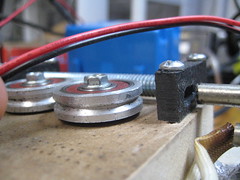I had noted that nophead and others were lubricating the filament to keep friction down on the filament during feeding, and for my design wanted to come up with a better way.
These rollers are skate bearings with an aluminum ring pressed around them. The rings only took a few minutes to make from a piece of aluminum tubing on the lathe.
The rollers are mounted on a small stud of drill rod with an eccentric hole, so that they are adjustable by twisting the mounting stud and tightening the screw.
I tried designs that had 3 rollers and that had only 1. Based on some basic calculations, i'd computed that i'd need about 6-8 threads to engage to make ensure that the filament would buckle coming out before the threads would strip the ABS, so I was unlikley that 1 roller would work. That turned out to be the case-- 1 roller does not force enough thread contact to feed under worst case conditions. 3 was overkill, so 2 is what i ended up with.
This version is just a lashup, the rollers are too far from the exit at this point, but still the concept works very well.
I believe that the adapter rings could be rep-rapped also, and perhaps a semi circular profile could be used in that case. I did a v-groove because I could use a 90 degree lathe tool i already had and didnt want to grind a semi-circular profile tool...

2 comments:
A problem with filament is that the diameter varies slightly. Can the adjustable screw once set, handle small variations in diameter? If not, would it possible to use a spring?
Yes, true. I have an alternate design drawn up that loads the rollers against the spring, but it didnt need it.
The filament i'm using seems to vary by about 0.008" max in the diameter along its length. I suspect that i've got it much tighter than the normal reprap-- the screw "digs" into the filament quite a bit. Thus, I think the screw just digs in a bit deeper when the filament is bigger. I have not measured it, but I'd say that it digs into the filament a good 0.010 or so. I'll post a picture of it.
I use a bigger motor than the rr extruder too.
I think that using springs would allow feeding with less digging into the filament, but this seems to work ok.
Its probably worth mentioning that i'm using closed loop control on the motor, so even in the case that the motor digs in a bit more or less here and there, the feed rate is still constant.
Post a Comment